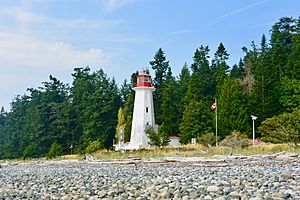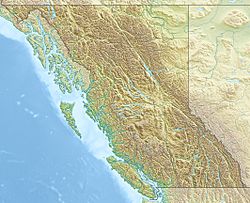Cape Mudge Lighthouse facts for kids
 |
|
| Cape Mudge Lighthouse | |
|
|
|
| Location | Quadra Island British Columbia Canada |
|---|---|
| Coordinates | 49°59′54.8″N 125°11′43.9″W / 49.998556°N 125.195528°W |
| Year first constructed | 1898 (first) |
| Year first lit | 1916 (current) |
| Construction | concrete tower |
| Tower shape | octagonal tower with balcony and lantern |
| Markings / pattern | white tower, red balcony and lantern |
| Height | 12 metres (39 ft) |
| Focal height | 17.5 metres (57 ft) |
| Characteristic | F WR |
| Admiralty number | G5580 |
| CHS number | CCG 0511 |
| NGA number | 12560 |
| ARLHS number | CAN-100 |
The Cape Mudge Lighthouse is an important building on Quadra Island. This island is located off the coast of Campbell River. It's on the east side of Vancouver Island in British Columbia, Canada. Lighthouses like this one help guide ships safely.
Contents
About Cape Mudge Lighthouse
The Cape Mudge Lighthouse has been a guiding light for many years. It helps ships avoid dangers and find their way along the coast. The first lighthouse was built here in 1898. The current lighthouse, which you can see today, started working in 1916.
Where is Cape Mudge Lighthouse?
This lighthouse stands on Quadra Island. This island is a short distance from Campbell River. It's part of the beautiful coastal area of British Columbia. The lighthouse is a landmark for sailors in the region.
How Cape Mudge Got Its Name
The name "Cape Mudge" was given by Captain George Vancouver. He was a famous explorer who sailed in this area in 1792. He named it after Zachary Mudge. Zachary Mudge served on Captain Vancouver's ship, the HMS Discovery. He also served on the HMS Providence in 1796.
A Special Job for the Lighthouse
From 1936 to 1985, the Cape Mudge Lighthouse had a very special extra job. It was part of the British Columbia Shore Station Oceanographic Program. Lighthouse keepers collected important information every single day. They measured the temperature and saltiness of the coastal water. This data was sent to the Department of Fisheries and Oceans. It helped scientists understand the ocean for 49 years. This long-term study was very important for learning about our oceans.


